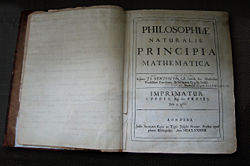Newton's Laws
They were first published by Sir Isaac Newton in his work Philosophiae Naturalis Principia Mathematica (1687) - all written in latin! The laws form the foundation of classical mechanics and can be used them to explain many results concerning the motion of physical objects. They still hold true for all sub-relativistic motion - once we get towards the speed of light we need to have Einstein's equations - which when v<<<<c simplify to Newton's Laws anyway. In the third volume of this work, Newton showed that these laws of motion, combined with his law of universal gravitation, explained Kepler's laws of planetary motion.(Kepler found an empirical relationship - knew mathematically how they behaved but not why this was so). These laws are sheer genius because they are elegant, simple and explain so many phenomena.
Simply stated, the three laws are:
|
Follow me...
|


 Newton's laws of motion are three laws of physics which describe mathematically the connection between the forces acting on an object and the motion of that object.
Newton's laws of motion are three laws of physics which describe mathematically the connection between the forces acting on an object and the motion of that object. 


